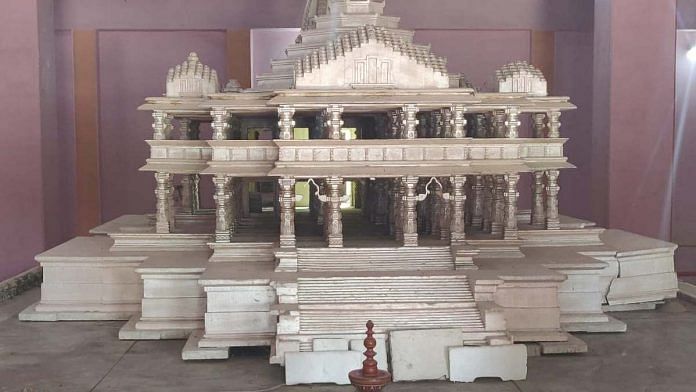New Delhi: The Ram Janmabhoomi Teertha Kshetra Trust has chosen Salil Sehgal, nephew of the late Ashok Singhal, who is considered the architect of the Ram Janmabhoomi movement, to sit alongside Prime Minister Narendra Modi to conduct the Ram temple’s bhoomi pujan (ground-breaking) ceremony at Ayodhya on 5 August.
Sehgal will sit with his wife and the prime minister for the ceremony, senior members of the trust told ThePrint.
“It is our way of expressing gratitude to the late Ashok Singhal ji, who played a key role in the Ram Janmabhoomi movement,” said Swami Govind Dev Giri, treasurer of the trust.
Also read: Ram Mandir can’t wait for Covid vaccine. Modi is Hindutva leader first, India’s PM later
Singhal — architect of the Ram temple movement
Singhal, who passed away in November 2015, was the Vishwa Hindu Parishad’s (VHP) international working president for over 20 years. He was also incharge of the Ram Janmabhoomi movement in Ayodhya.
In 1984, Singhal decided to launch a campaign to build a temple in Ayodhya where the erstwhile Babri Masjid stood.
He was at the helm of the Ram Janmabhoomi Kar Sewa movement and was present in Ayodhya when the Babri Masjid was demolished on 6 December 1992.
Salil is the son of Singhal’s elder brother Parmod. Singhal’s second nephew Mahesh Bhagchandka, who runs the Ashok Singhal foundation, will also be present at the ceremony.
A senior member of the trust told ThePrint that PM Modi will reach the premises in Ayodhya at 12 pm.
“The main prayer ceremony will take place between 12.30 and 12.45 pm. which is the most auspicious time that day. The other ceremonies will continue after that,” he said.
Once the bhoomi pujan is completed, the construction work for the Ram temple will officially begin. The trust has fixed a 2024 deadline to complete the temple.
Also read: Reader View: Building Ram Mandir now is not the right time, Modi shouldn’t attend ceremony
Preparations for 5 August
Kameshwar Chaupal, another member of the trust, said the celebrations in the temple town will start from 3 August itself.
“We are appealing to Ayodhya residents to light diyas outside their homes and conduct havan. It’s a historic occasion for everybody. Because of Covid-19, the invitees number has been limited to 200. But those who can’t be present physically can pray at home,” he said.
Furthermore, VHP volunteers are already on the ground at Ayodhya making arrangements for 5 August.
“The VHP was in the forefront of the Ram Janmabhoomi movement. Our workers have been working round the clock to make the ceremony a big success,” a VHP leader told ThePrint.
VHP volunteers have also been working at the workshop in Karsevak Puram for the last 30 years to build the temple.
ThePrint had on 10 November 2019 reported how volunteers had already prepared hundreds of boulders in red sandstone with intricate carvings along with designed wooden panels that have fine detailing and ‘Jai Shree Ram’ embossed on each brick.
A model of the Ram temple designed by noted architect Chandrakant Sompura has also been placed at the entry point of the workshop. While the design of the temple will continue to be the same, it has now been expanded to accommodate more people.
The height of the temple will be 161 feet now as opposed to the earlier 148 feet.
Also read: Ram Janmabhoomi struggle was about restoring national pride, not religion, says RSS mouthpiece
Swami Govind Dev Giri, treasurer of the Ram Janmabhoomi Teertha Kshetra Trust, was incorrectly referred to as Swami Govind Dev Puri. The error is regretted.




May be a far cry. Will the temple complex have a compound wall in typical Muslim style (we can see this in the town of vaniambadi on NH 47 connecting Chennai and Bengaluru) with Muslim style arches and the Masjid to be built reciprocate by the typical alternating vertical stripes of while and saffron paintings in their compound wall.
Shri Moropant Pingle and Shri Dattopant Thengdi were the true architects of the Shri Ram Janmabhoomi movement.